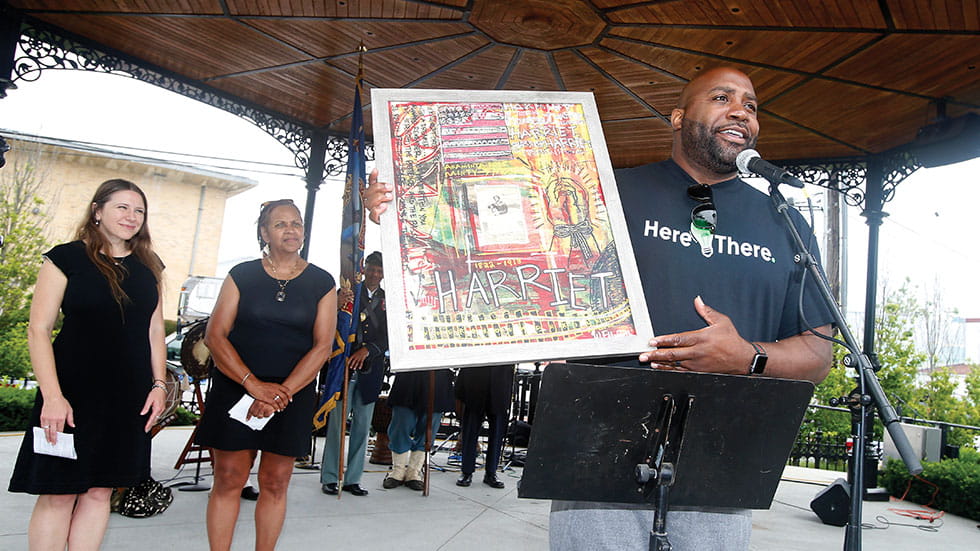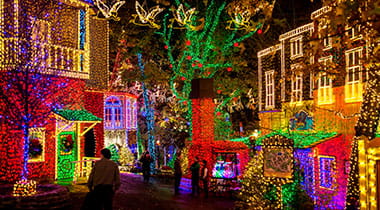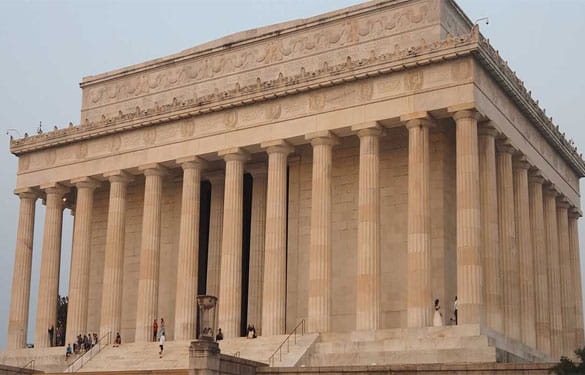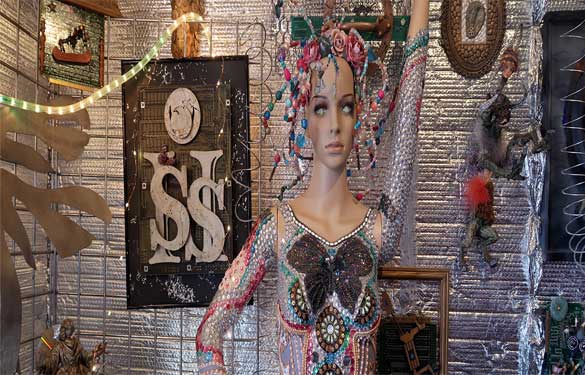In the darkness of a spring night in 1860, six enslaved individuals—four men and two women—pushed off the Delaware shore in an old bateau. The beacon of the Cape May Lighthouse would serve to guide them across the 17-mile stretch of the Delaware Bay to New Jersey—and freedom.
They were soon attacked by a group of white men in a boat who fought with and fired on the party, wounding the men. The runaways were injured but continued to row furiously across the bay. Eventually they came ashore on a beach not far from the lighthouse.
An oysterman approached them as morning dawned and offered to ferry them to Philadelphia for $25; it was all the money they had on them. They agreed. Thus, these six individuals who had fled enslavement in Worcester County, Maryland, became the final documented case of freedom seekers to escape to Philadelphia by way of Cape May County.
Philadelphia artist Kate Brockman donated her sculpture Fearless in Fear: A Young Harriet Tubman to the Harriet Tubman Museum of New Jersey. Photo Courtesy of Photo © 2021 Tim Hawk for the Harriet Tubman Museum
A DEEP DIVE INTO HISTORY
This harrowing tale—with details added from an account set down soon after the events took place in 1860—was among many recounted on my excursion on the Cape May MAC Underground Railroad Trolley Tour this past spring.
I’ve written about travel through the lens of African American history for more than 40 years, and although I was generally aware of the role of Cape May and the rest of New Jersey in the Underground Railroad (UGRR) network, there was much I didn’t know.
The intimate stories related by the tour guide and visits to authentic locations heightened my awareness of a more holistic story of African American freedom seekers and the community that supported them. Access to these in-depth narratives gave me a renewed sense of purpose as a chronicler of the hidden stories and silent saviors.
The narrated 90-minute UGRR trolley tour departs Washington Street Mall in downtown Cape May. (Reservations are suggested; check capemaymac.org for tour times.) The tour stops at a few sights related to the UGRR, including a beach in West Cape May with a view of the Cape May Lighthouse.
The major focus of the excursion, however, is the personal stories of those who fled enslavement and the individuals who assisted them. The narratives shared by the tour guides were culled from archives and documented oral testimonies as well as the 1872 book The Underground Railroad by abolitionist William Still (the source for some of the details in my opening story), which compiles the tales of hundreds of escaped slaves who passed through Philadelphia during Still’s time with the UGRR.
Born a free Black in New Jersey to parents who had escaped slavery, Still documented these stories, he wrote, in the hope that by carefully gathering the narratives of Underground Railroad passengers “might at least some of the bleeding and severed hearts be united and comforted.”
New Jersey was a stop for many enslaved people who fled north because it was located at the crossroads between the slave-holding states of Delaware and Maryland as well as those farther south and the urban UGRR hubs of Philadelphia and New York.
Additionally, New Jersey had more free Black communities than any other Northern state, and these enclaves provided shelter for fugitives and access to the four major routes to freedom that passed through New Jersey, all of which eventually merged and led to the Philadelphia Line, New York and Canada. Cape May County was part of the state’s Southern Network Line, which also included Cumberland, Salem and Atlantic Counties.
Cape May MAC offers Underground Railroad Trolley Tours
TREASURED SITES AND STORIES
After finishing the trolley tour, visitors can learn more by exploring a few sites that were integral to Cape May’s African American history. Chief among them is the Harriet Tubman Museum of New Jersey (harriettubmanmuseum.org), which occupies the historic 1850s Howell House that served as the parsonage of the Macedonia Baptist Church from 1909 to the early 1980s.
Tubman had been born into slavery in Dorchester, Maryland, and escaped in 1849. Her association with Cape May began soon thereafter. It is believed that she spent the summers from 1849 to 1852 working as a cook in one of Cape May’s hotels, likely the Banneker House, which at the time was one of the only seaside resorts in the country for free Blacks.
Because slave hunters had not yet identified Tubman for her work helping others to flee slavery, she was able to move about freely, raise funds and establish contacts for her subsequent winter freedom forays. Most likely, she interacted with the prominent abolitionists who often held meetings in Cape May. Cape May’s central UGRR agent, Edward Turner, assisted Tubman in her work and personally conducted fugitives along the route.
In an 11-year period after her escape, Tubman returned to Maryland 13 times and rescued a documented 70 people. She went on to become a nurse, spy, scout and leader of Union troops during the Civil War.
Although the new museum, which opened on Juneteenth, is named for Tubman, the exhibits in its three main galleries provide a broader context on the African American story.
The Africa Room features artifacts, artwork, documents and video presentations, many of which are on loan from the large private collection of Reverend Davis, pastor of Cape May’s interracial Macedonia Baptist Church from 1963 until 2009. The masks, carvings, utilitarian objects and slave manacles on display represent a small fraction of Davis’ collection, procured on his travels in the Southern US and elsewhere.
The Grand Gallery relates stories of the UGRR and individual abolitionists who worked in Cape May and elsewhere in New Jersey. An extensive display in the Grand Gallery is devoted to Still, who, in addition to his work on the UGRR, was Chairman of the Vigilance Committee of the Pennsylvania Anti-Slavery Society. A rare early edition of his Underground Railroad—the only known firsthand documentation of the Underground Railroad published by a Black person—is among the museum’s gems.
The final gallery in the museum, the Legacy Room features a timeline of Cape May’s Black community. Free Blacks and emancipated slaves formed communities that were instrumental in hiding, clothing, funding and transporting freedom seekers. Photographs of early residents and documents of deeds and programs help bring these stories to life. Well, into the mid-20th century, Cape May had vibrant African American neighborhoods with Black-owned businesses and entertainment venues.
Darrell Edmonds, executive director of the New Jersey mentor organization Friday Is Tie Day, presents a work by DC artist W. Ellington Felton to the Harriet Tubman Museum of New Jersey at the museum’s Grand Opening on June 19. Photo Courtesy of Photo © 2021 Tim Hawk for the Harriet Tubman Museum.
Directly across the street from the museum is the 1846 Stephen Smith House (stephensmithhouse.org), which, like the trolley tour, is part of the National Park Service’s Network to Freedom program, created to “honor, preserve and promote the history of resistance to enslavement through escape and flight.”
Smith, born in 1795 in Lancaster, Pennsylvania, purchased his freedom in 1818 for $50. He went on to invest in banking, lumber, real estate and coal, becoming the wealthiest Black man east of the Mississippi. He donated large amounts of money to the abolitionist movement, and in the 1830s, he purchased a hall in Philadelphia for the movement’s use; it was burned down by a mob in 1838.
In the 1840s and 1850s, Smith’s summer home in Cape May served as a central gathering and meeting space for Black leaders, including Tubman, Still and Frederick Douglass. When the historic house was scheduled for demolition as part of a 1960s urban renewal plan, a plea went out to President Lyndon Johnson, who replied by telegram immediately and saved the home. Smith’s home still awaits restoration and can only be viewed from the outside (645 Lafayette Street).
The Banneker House, the 30-room hotel where Tubman is believed to have worked, had stood next to Smith’s home in the 19th century. It was the site in 1855 of a convention of the era’s leading African Americans, and debates, speeches and anti-slavery rallies were held there regularly. The Banneker House was torn down at some point, and the lot on which it stood is now a park.
My recent Black history-focused visit to Cape May surprised me because the story of the town’s role in the UGRR is so easily accessible thanks to the trolley tour and the Harriet Tubman Museum. The stories told highlight the Black impact on the quest for freedom and the profound effect of ordinary individuals of all ethnicities and religions going to extraordinary lengths for a moral imperative.


















